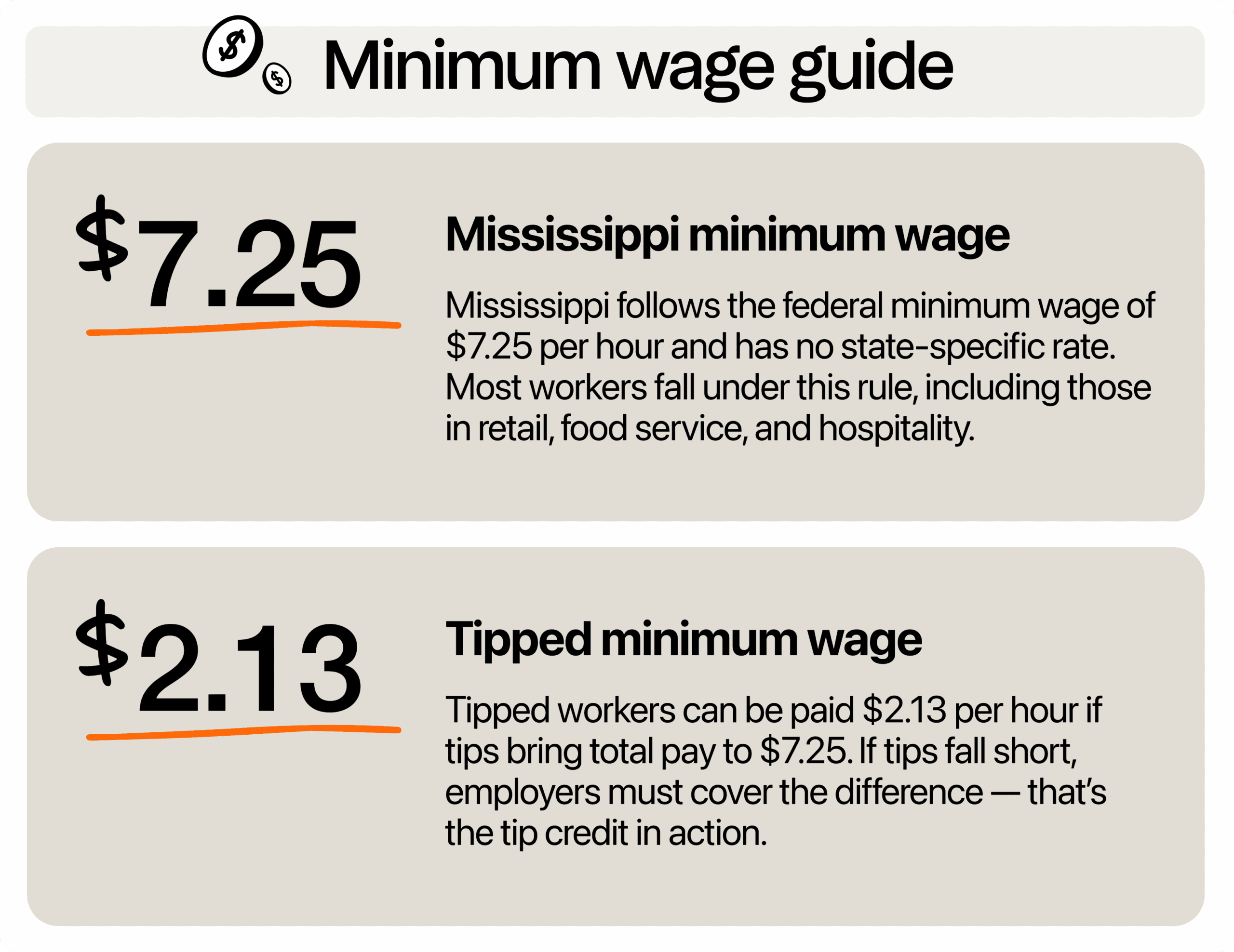Mississippi minimum wage follows the federal rate, which is way lower than the average salary of servers and hosts. It’s also lower than neighboring states’ minimums, making it challenging for restaurant owners to attract skilled workers who might easily cross state lines for better pay. That’s why it’s important to stay informed of the wage laws and how you can stay competitive in the local job market.

What is the minimum wage in Mississippi?
Mississippi doesn’t set its own minimum wage. Instead, it follows the federal minimum wage of $7.25 per hour, which hasn’t changed since 2009.
The state also uses the federal tipped wage system for tipped staff, like servers and bartenders. Employers can pay as little as $2.13 per hour, but only if tips make up the rest so that the worker reaches $7.25. If tips don’t add up, the restaurant has to cover the difference, which is known as the tip credit.
For instance, if a server makes $15 in tips for a 5-hour shift, their employer must pay $10.65 (direct cash wage) and another $10.60 to meet the minimum wage requirements.
Take note that Mississippi law allows a few subminimum wage exceptions under the FLSA. Workers under 20 years old can earn $4.25 per hour for their first 90 days of providing services. After that, they must move to the standard $7.25.
Full-time students in service or retail jobs can be paid 85% of the federal minimum, about $6.16 per hour, but only with a certified student wage certificate from the Department of Labor.
Is there a law being made to raise the $7.25 wage?
Right now, no state law has passed to raise Mississippi’s minimum wage, but several proposals have been introduced in recent years.
In the 2025 legislative session, two Senate bills, SB 2440 and SB 2172, sought to increase the wage to $12 per hour in 2026 and $15 per hour by 2028. These didn’t pass and died in committee.
Earlier efforts in 2024 included HB 71, proposing a base wage of $10 per hour with tipped staff starting at $3.62 per hour. Then, there’s HB 306, which aimed for an $8.50 per hour floor. Both also didn’t pass.
Mississippi cities and counties can’t pass their own higher wage laws, due to a state law that blocks local wage control. That means even if a town wants to offer more, it legally can’t.
At the federal level, Congress is considering the Raise the Wage Act of 2025 (S.1332), introduced in April 2025. This law would raise the federal minimum wage to $17 per hour by 2030. If it passes, it’d automatically override state minimums, including Mississippi’s. That’s a big shift that restaurant owners should keep an eye on, especially since The Magnolia State follows all federal law by default.
How does the state minimum compare to neighbouring states?
Mississippi’s rate is part of a group of states with the lowest minimum wages, including Alabama, Tennessee, and Louisiana. Things look different across the border, though.
Arkansas minimum wage is higher at $11 per hour, with cash wages at $2.63 per hour. To the north, Missouri’s minimum jumped to $13.75 per hour at the start of 2025, with plans to reach $15 by 2026 under a voter-approved ballot initiative.
What does this mean for Mississippi restaurants? Low pay in the state can push talent across borders. Talent in Benoit, Rosedale, and Southaven can easily drive to Arkansas and Missouri to enjoy at least $3 more per hour.
Can local workers live off the minimum?
The MIT Living Wage Calculator estimates a living wage in Mississippi of about $20.75 per hour for a single adult with no children. Meanwhile, two parents with two kids would need to earn $37.44 per hour each.
That poverty wage forces many minimum-wage workers to clock about 86 hours per week just to pay rent on a 2-bedroom apartment. That’s more than a full-time second job, just for basic housing. When minimum wage doesn’t cover the basics, workers are more likely to call out or pick up extra jobs. They might leave altogether for better pay, if not in-state, then across state lines.
How to stay competitive in a low-wage state
In a low-wage state like Mississippi, you need to offer competitive pay and perks to encourage employees and potential hires to stay. Investing in people and fostering a positive work environment can give your restaurant an edge and keep your team loyal.
Offer more than the bare minimum
Paying just $7.25 per hour won’t cut it when you’re trying to hire and retain good staff. The average server salary is at least $15 per hour, while a host or hostess earns around $14 per hour. Offering lower wages can pose challenges in attracting and retaining talent.
High turnover can be very expensive for your restaurant. The cost of replacing a single FOH employee is $1,000. This rises to nearly $1,500 for BOH staff, while it goes as high as $2,600 for managers.
If your restaurant loses 10 FOH team members yearly, you’re looking at around $10,000 in hiring costs and productivity losses. Even a small raise can keep staff longer, letting you save big money.
For instance, if you raise a team member from $7.25 to $9 per hour, they get an extra $3,640 annually (assuming 40-hour work weeks). At first glance, it might seem more expensive than the cost of replacing them.
However, you must remember that keeping them means you avoid disruptions in operations while boosting team morale. Plus, they’re more likely to take ownership and pride in their roles and provide consistent service.
If you can’t bump wages much above the minimum, add perks that matter to your team. In our restaurant employee engagement report, paid time off (50%) and health insurance (38%) are the top two benefits workers want.
Be transparent about pay and advancement
In the same report, 28% of employees are looking for growth opportunities. It’s important for restaurant owners and operators to be clear about pay and career growth options.
Make sure to explain what employees need to do to get a raise or a better shift. For example, let servers know they can earn an extra $1 per hour after six months if they keep a 90% on-time record and average 4.5‑star guest ratings. That way, your team sees a clear path from entry pay to better earnings.
Write down exactly how tips are collected and shared as well. Who’s in the pool? How do you split based on hours or roles? Have everyone sign off and post it where staff can read it.
Being open about pay structure makes employees feel that they’re actually key players in your team. In turn, this can help them stay motivated and committed to your restaurant’s success.
Make onboarding fast and friendly
Bringing on a new team member is your chance to set the tone for their future at your restaurant. A strong onboarding process helps new workers feel confident and supported, especially in a low-wage state like Mississippi, where competition for staff is fierce.
When minimum wage is stuck at $7.25 per hour, new hires are more likely to leave for slightly higher-paying roles unless they feel engaged from day one. That’s why a thoughtful start is worth the effort.
Begin with the basics. Introduce your team, walk through expectations, and make sure they understand your systems. Assign a “day-one buddy” or mentor who can answer questions during their first few shifts. This helps reduce confusion, builds trust, and gets them up to speed quickly.
Follow up regularly in the first 30 days. Ask new staff what’s working and what isn’t. If they don’t understand the wage laws or feel underprepared, that’s your signal to tweak training.
Recognize and reward effort
The day-to-day in a restaurant can be grueling and stressful. Just a simple shoutout can make your team members feel seen and valued. Start each shift with a team huddle and recognize someone who went above and beyond in the last shift. Maybe a server handled a complex customer complaint perfectly, or a host helped clean up during a rush without being asked.
Make sure that recognition is more than just verbal praise. A simple $25 gift card or letting them get first pick of next week’s shifts can go a long way.
Assign managers to track performance and developments. Have them include details like the date and specific achievements that warrant recognition. These documents can then be used for annual performance reviews, helping both employees and management track growth and potential.
Ask your team what they need and actually listen
If you’re unsure of what incentives your team likes, you should ask them directly. Run monthly pulse surveys to know what motivates your staff. Ask about their preferred benefits, work environment preferences, and suggestions for improvement.
Keep the survey short, with around 5 to 7 questions, and anonymous. Another option is to hold one-on-ones during non-busy shifts. Even a quick 5-minute chat with each team member can let them share small concerns before they worsen.
For example, you can ask, “What’s one thing you’d change about our schedule next week?” These check-ins show your team you’re paying attention.
You can also create suggestion boxes, either physical in the back office or digital. Let staff drop in ideas for shifts, menu items, or workplace changes. Assign one manager to gather the data and report it to the other managers.
The most important thing here is to show that you’re genuinely listening and taking action. When employees see their feedback being implemented, they feel respected and more connected to the workplace.
Support your managers
Your managers are your link to the crew and entire operations. When you equip them with the right tools and support, they can create a more positive and productive work environment.
First, train them in people management, not just operations. They need more than how to run the kitchen or close the books. Teach them how to give constructive feedback, spot burnout before it hits, and coach employees through their shifts.
Next, give them tools that automate tedious tasks. For example, restaurant scheduling software can help them assign shifts easily, while restaurant payroll management platforms automate calculations for pay and tips, improving wage compliance. These tools can save them hours, which they can use to focus on coaching their team.
Lastly, reward managers for strong team performance, not just sales. Most incentives focus on hitting revenue targets, but your managers’ real wins are in crew engagement, low turnover, and consistent service.
Rewards could be a bonus for a high morale month or extra paid time off. The goal is to show managers that their leadership and team-building skills matter just as much as financial performance. By shifting focus from pure numbers to holistic team success, you create a more supportive and motivating environment.
Raising the bar
Mississippi’s wage isn’t increasing any time soon, but it doesn’t mean you should stay stuck paying the state rate. As much as possible, invest in your team to build a workplace that attracts and keeps great people.
Offset expenses by managing labor costs with restaurant management software. With 7shifts, you can optimize schedules to avoid unnecessary overtime payments. This way, you can create a more efficient workflow that benefits both your staff and bottom line.

Rebecca Hebert, Sales Development Representative
Rebecca Hebert
Sales Development Representative
Rebecca Hebert is a former restaurant industry professional with nearly 20 years of hands-on experience leading teams in fast-paced hospitality environments. Rebecca brings that firsthand knowledge to the tech side of the industry, helping restaurants streamline their operations with purpose-built workforce management solutions. As an active contributor to expansion efforts, she’s passionate about empowering restaurateurs with tools that genuinely support their day-to-day operations.
